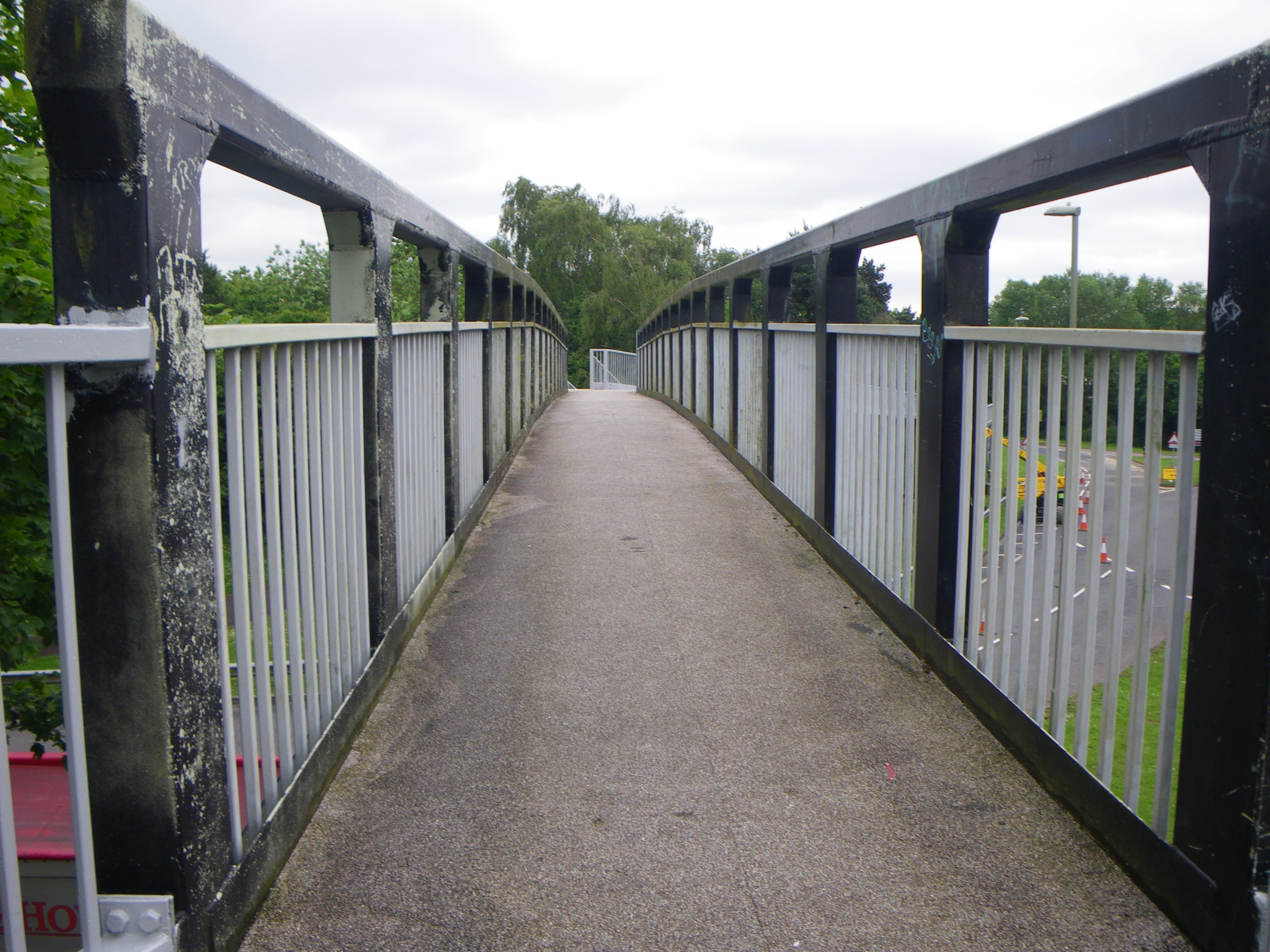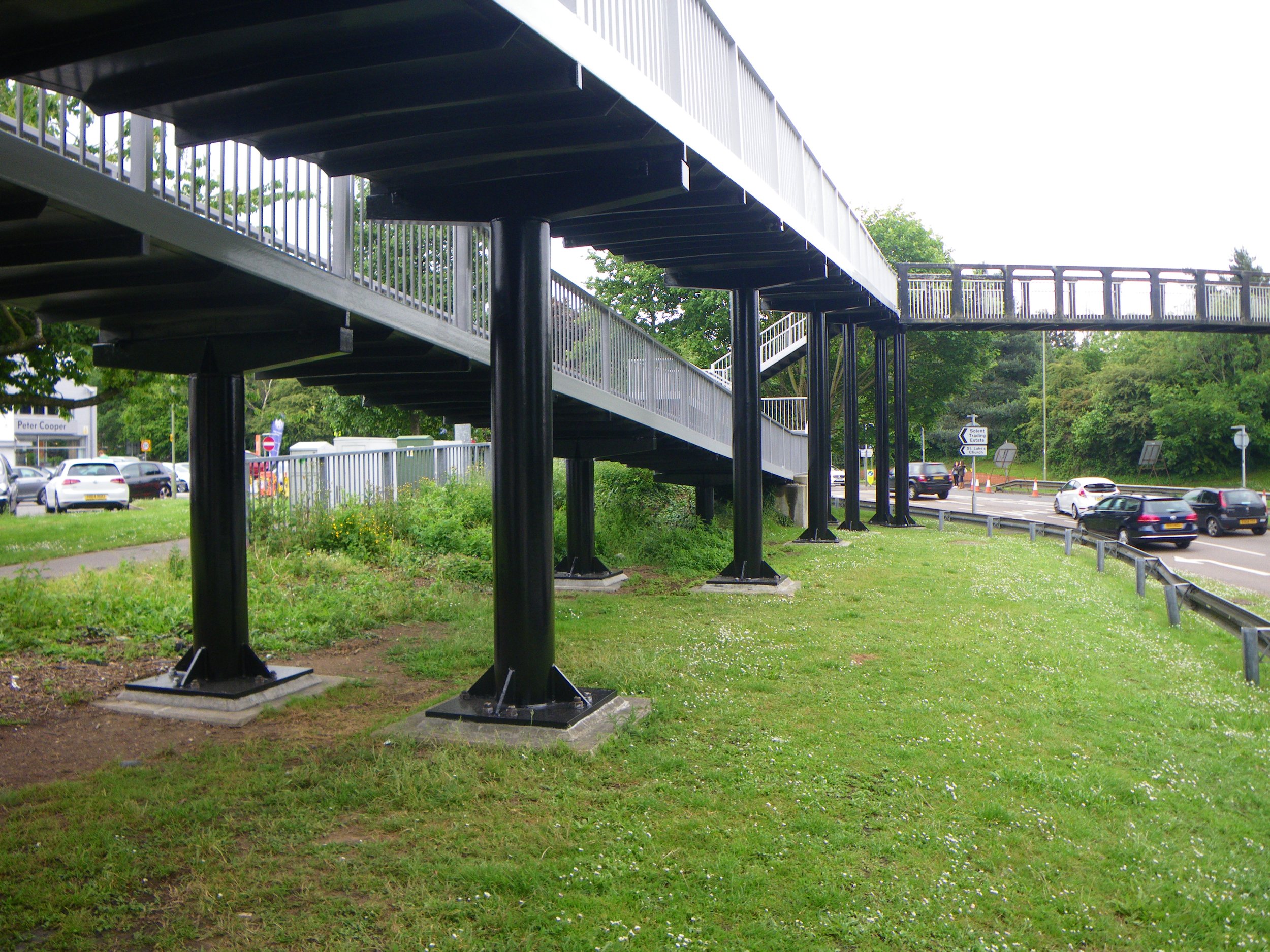Hedge End Footbridge
Refurbishment of the Hedge End footbridge system in Southampton is nearing completion following a necessary break for winter weather. The work, for Hampshire Country Council, is part of a series of Bridge works across the county, the third consecutive year that Rhinoceros have won contracts from HCC.
The project started with high pressure 200 bar clean, followed by abrading to clean steel or sound paint and repainting with HA protective coating system. Cleaning however revealed that previous coatings were substandard, and in liaison with the Council-appointed paint inspectors it was determined that large sections of the supports, parapets and handrails should be taken back to bare metal before new coatings would adhere.
The inset photo shows the surface problems, which concealed underlying defects, requiring complete removal back to bare metal on several sections before new coatings could be applied.
Intensive work was completed in the Autumn to ensure the structure was left in a stable condition before winter weather fully took hold.
The job began with cleaning the existing coatings (using an Alto Contractor high pressure waster blasting machine, silent running at 200 bar with turbo nozzles). This was extremely effective at removing the grey top coat, but in places all existing coatings back to bare steel also disbonded. The paint inspector discovered that the original first coating, a metal spray, showed poor adhesion in some areas.
A casual inspection prior to cleaning had suggested that the existing gloss finish was simply well weathered, appearing matt over large areas. But in fact the high pressure cleaning was simply removing a previously unsuspected matt black coat, which had been applied over a high gloss polyurethane original finish coat. This matt black paint was found to soften with the application of solvent, and was probably an acrylic coating – it could never have adhered well to the high gloss polyurethane.
Following the paint inspector’s advice, Hampshire County Council instructed Rhinoceros to remove all of the black polyurethane back to a sound intermediate coat. This was to be carried out on all of the affected parapets, beams, and columns to stairs and ramps. One stair structure was in even worse condition, probably a result of being under surrounding trees, and required a complete removal of existing coatings back to clean steel. It was found here that the original blast profile, prior to application of the faulty metal spray coat, was close to 50 microns. It should have been 100 microns.
After four weeks of good weather progress was hampered by September rain: paint application was out of the question most mornings, and frequently all day. To add further complication the footbridge was used by several hundred schoolchildren, so little work was possible around their arrival and leaving times. Rhinoceros had to arrange 06:30 starts and 18:30 finishes, sometimes staying on till 19:30 to complete a section.
After cleaning, removal of existing coatings back to clean steel on the worst section started in August - by hand, using flap discs, a small belt sander and tungsten carbide scrapers. Clean steel was wiped down with solvent rag, and coated with Sigmacover 690 to approx 120 microns. Rhinoceros continued working on further sections, removing 100% of the black topcoats back to a sound intermediate coat, again using flap discs and scrapers. Slight dishing of steel sections meant that some areas of metal were exposed, but generally dft readings in the range of 200-250 microns after abrading were achieved. The first coat was then applied - a surface tolerant primer, Sigmacover 690.
Work continued through September and October, dodging changeable weather, and surface preparation and primer application to all important areas was completed. An intermediate coat (Sigmacover 456HS) was applied by brush and striker to bring the average dft above 250 microns, leaving the structure ready for topcoat after winter
Following the enforced winter break, work has progressed rapidly and large areas of the bridge have been completed, with abrading of the main bridge span now able to move forward in sympathetic conditions.








